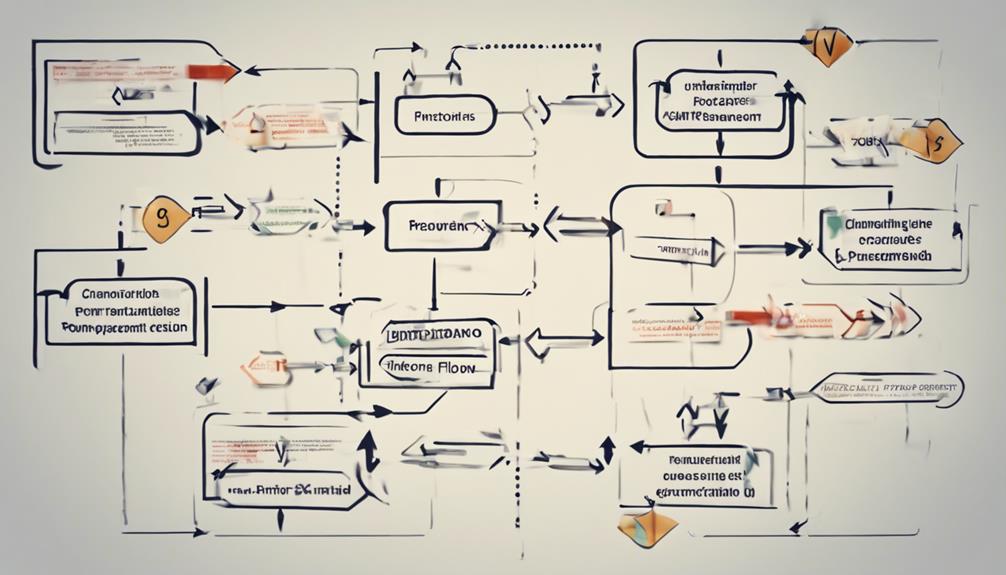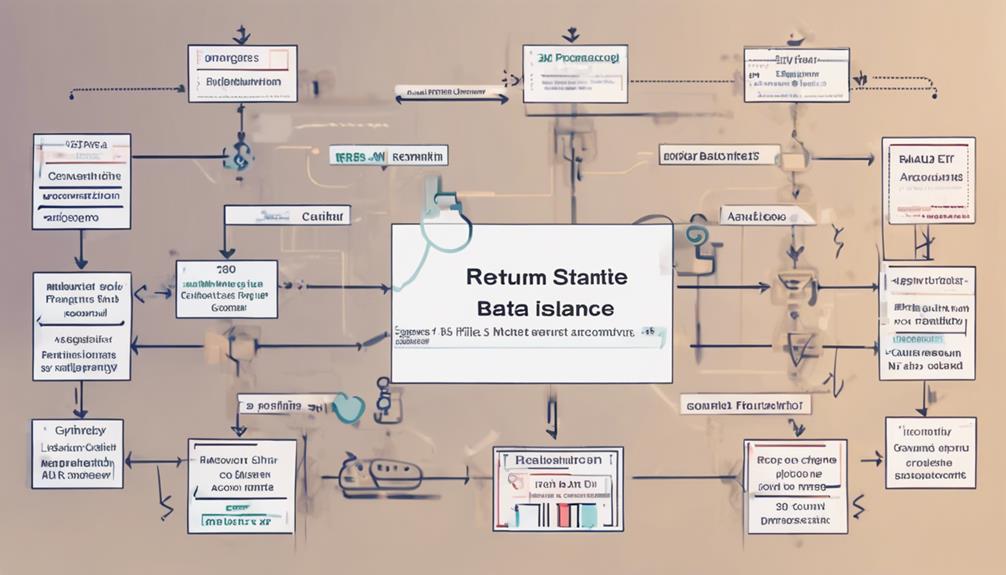Miscellaneous Business Services
Decoding ACH Returns: Navigating Electronic Payment Hurdles
Unravel the complexities of ACH returns and overcome electronic payment challenges with essential insights – a must-read for financial proficiency.

Understanding ACH returns is crucial in successfully maneuvering electronic payment hurdles. ACH returns occur when transactions fail to meet set criteria and are sent back through the ACH network. Return codes help identify reasons for failures, initiated by the RDFI within a 60-day timeframe. Distinct from reversals, returns focus on resolving transaction issues following NACHA guidelines. Initiating a return involves notifying the bank promptly, providing transaction details, and deciphering alphanumeric return codes. Prevent return issues by verifying account information, monitoring balances, setting payment controls, and using automated notifications. Mastering these aspects guarantees smoother financial operations. Discover strategies to enhance your handling of ACH returns.
Key Takeaways
- Understand ACH return codes (e.g., R01, R02) to identify transaction failure reasons efficiently.
- Initiate ACH returns within 60 days for failed transactions to rectify issues promptly.
- Implement account verification and monitoring practices to prevent common return reasons.
- Utilize payment controls and notifications to minimize ACH return risks effectively.
- Promptly notify the bank with transaction details to initiate the ACH return process.
Understanding ACH Return Process

Understanding the process of ACH returns is essential for efficient financial management. ACH returns occur when a transaction fails to meet specific criteria and is consequently sent back through the Automated Clearing House network.
These returns encompass both debits and credits, with refunds being directed back to the originating bank. By grasping the various return codes associated with ACH transactions, one can easily pinpoint the reasons behind transaction failures.
It's important to note that ACH returns differ from ACH reversals, as they're initiated by the Receiving Depository Financial Institution (RDFI) due to transaction issues, following guidelines set by NACHA.
A 60-day timeframe exists for initiating ACH returns, offering a structured approach to rectifying failed transactions and ensuring smooth financial operations.
Key Differences: ACH Return Vs. Reversal

Moving from the process of ACH returns, distinguishing between ACH return and reversal initiators sheds light on key differences in electronic payment management.
ACH returns are initiated by the Receiving Depository Financial Institution (RDFI) in response to transaction issues, following guidelines set by NACHA. These returns must be initiated within a 60-day timeframe.
On the other hand, ACH reversals are initiated by the Originating Depository Financial Institution (ODFI) before settlement completion to correct errors. Reversals have a shorter initiation timeframe compared to returns.
Understanding these distinctions is essential for businesses and individuals exploring the world of electronic payments to guarantee efficient financial operations and mitigate risks effectively.
Initiating an ACH Payment Return

To initiate an ACH payment return, notify the bank of the transaction issue promptly. When dealing with ACH return processes, it's crucial to follow specific steps to guarantee a smooth return transaction. Here are some key actions to take:
- Contact the bank to inform them of the need for an ACH payment return.
- Provide all necessary details regarding the transaction and the reason for the return.
- The bank will initiate the return process through the ACH network on your behalf.
- Once processed, the originating bank will be notified, and the necessary adjustments will be made promptly.
Deciphering ACH Return Codes

When decoding ACH return codes, businesses must familiarize themselves with the alphanumeric codes that signify transaction failure reasons. These codes, starting with 'R' followed by two digits, provide valuable insights into why a transaction was unsuccessful.
Common ACH return codes include Insufficient Funds (R01), Account Closed (R02), No Account/Unable to Locate Account (R03), and Invalid Account Number (R04). Monitoring these codes is essential for efficient bookkeeping and operational effectiveness.
Strategies to Prevent ACH Return Issues

Implementing proactive measures can effectively reduce ACH return issues and enhance financial transaction efficiency.
To prevent ACH return problems, businesses can:
- Verify Account Information: Confirm accurate account details to prevent common return reasons like Invalid Account Number (R04).
- Monitor Account Balances: Regularly check account balances to avoid Insufficient Funds (R01) returns.
- Implement Payment Controls: Set limits or pre-authorization requirements to minimize the risk of returns.
- Utilize Automated Notifications: Receive alerts for low balances or failed transactions to take immediate action and prevent returns.
Frequently Asked Questions
Can ACH Returns Be Initiated by the Originating Bank?
ACH returns can't be initiated by the originating bank. These returns are typically initiated by the Receiving Depository Financial Institution (RDFI) due to transaction issues. NACHA guidelines govern the ACH return process, outlining a 60-day timeframe for initiation.
In contrast, ACH reversals are initiated by the Originating Depository Financial Institution (ODFI) before settlement completion to correct errors, with a shorter initiation timeframe. Understanding these distinctions is essential for managing electronic payments effectively.
Are ACH Returns Subject to a Time Limit for Resolution?
ACH returns are subject to a time limit for resolution. According to NACHA guidelines, financial institutions have 60 days to initiate ACH returns. This timeframe guarantees prompt handling of transactions that don't meet the required criteria.
Understanding this deadline is crucial for efficient management of electronic payments and maintaining smooth financial operations. Timely resolution of ACH returns contributes to improved cash flow and reduced risks for businesses.
What Happens if the RDFI Doesn't Process an ACH Return?
If the RDFI doesn't process an ACH return, the originating bank may face challenges. Delays in resolving failed transactions can impact financial operations. It's important for the RDFI to promptly address ACH returns to maintain smooth payment processes.
Timely action guarantees that errors are rectified efficiently, preventing disruptions to cash flow and financial stability. Effective communication and adherence to NACHA guidelines are essential in managing ACH return situations.
Can ACH Return Codes Be Customized by Each Financial Institution?
ACH return codes can't be customized by each financial institution. These codes are standardized within the ACH network to guarantee consistency and clarity across all transactions. Standardization helps streamline the return process and allows for easier identification of transaction failure reasons.
Financial institutions must adhere to these predefined codes to maintain compliance with NACHA guidelines and facilitate efficient handling of ACH returns.
How Do ACH Returns Impact a Company's Credit Rating?
When considering a company's credit rating, ACH returns can impact it negatively if frequent occurrences indicate financial instability. Excessive returns may signal cash flow issues or poor transaction management.
Monitoring ACH return patterns is essential to maintain a positive credit rating. Proactive handling of returns and adhering to NACHA guidelines can help prevent negative effects on a company's creditworthiness.
Understanding ACH return codes and addressing issues promptly is key to safeguarding credit ratings.
Conclusion
To sum up, maneuvering through the world of ACH returns demands vigilance and understanding to guarantee smooth financial transactions.
By decoding ACH return codes and implementing proactive strategies, individuals and businesses can prevent payment hurdles and maintain a seamless flow of funds.
Remember, staying informed and prepared is the key to conquering the vast ocean of electronic payments with finesse and precision, making any obstacle seem as small as a drop in the financial bucket.
Miscellaneous Business Services
Key Roles of ACH Operators Unveiled
Mystery surrounds the crucial roles of ACH operators in ensuring seamless electronic payments – uncover their vital functions here.

ACH operators play an essential role in the electronic payment ecosystem by overseeing transaction routing, ensuring NACHA guideline adherence, managing risks effectively, and safeguarding financial transactions to prevent fraud, errors, and delays. They select the best routes based on cost, speed, and reliability, validate transaction details for accuracy, and operate under NACHA rules. The primary ACH operators in the U.S., like the Federal Reserve and Electronic Payments Network, form the backbone of the ACH network, overseeing clearing, settlement processes, and facilitating electronic fund transfers efficiently. Discover more about the key responsibilities and functions of ACH operators in ensuring seamless electronic payments.
Key Takeaways
- Oversee transaction routing, clearing, and settlement processes efficiently.
- Ensure strict adherence to NACHA guidelines and industry standards.
- Manage risks effectively to safeguard financial transactions.
- Direct payments accurately to intended recipients.
- Contribute to the smooth operation and integrity of the ACH network.
ACH Operators Responsibilities Breakdown

ACH operators play an essential role in the electronic payment ecosystem. They oversee transaction routing, clearing and settlement, adherence to NACHA guidelines, and managing risks.
They ensure that payments are directed efficiently to their intended recipients, process transactions accurately, and follow industry standards to maintain the security and reliability of the payment network. By carefully monitoring and verifying each step of the payment process, ACH operators help prevent fraud, errors, and delays in electronic payments.
Their commitment to upholding NACHA guidelines and implementing robust risk management practices is critical in maintaining the integrity and smooth operation of the ACH network. Ultimately, this benefits businesses and consumers who rely on electronic payments for their financial transactions.
Essential Functions of ACH Operators

Operating within the electronic payment ecosystem, ACH operators perform vital functions essential for the smooth and secure processing of financial transactions. These functions include selecting best routes based on factors like cost, speed, and reliability, validating transaction details to guarantee accuracy, and operating under NACHA rules and regulations to ensure compliance.
ACH operators also play a significant role in safeguarding financial transactions, maintaining the integrity and security of the payment process. By fulfilling these essential functions, ACH operators contribute to the efficient operation of the ACH network, ensuring that electronic payments are processed accurately and securely, benefiting both businesses and consumers alike.
Primary ACH Operators in the U.S

In the United States, the Federal Reserve and the Electronic Payments Network (EPN) are pivotal in handling clearing, settlement, and verifying transaction authenticity within the ACH network.
The Federal Reserve plays a vital role in overseeing the clearing and settlement processes, ensuring the smooth flow of funds between financial institutions. It also verifies transaction authenticity to prevent fraud and maintain the integrity of the ACH network.
On the other hand, the Electronic Payments Network (EPN) facilitates electronic fund transfers by processing and settling electronic transactions efficiently.
Together, these primary ACH operators in the U.S. form the backbone of the ACH network, ensuring the secure and reliable transfer of funds across the country.
Frequently Asked Questions
How Do ACH Operators Handle Transaction Disputes?
ACH operators handle transaction disputes by reviewing the details provided by both parties and investigating the transaction thoroughly. They work to resolve disputes promptly and fairly by following established protocols and guidelines.
Operators communicate with the involved financial institutions to gather necessary information and reach a resolution. Through this process, they aim to guarantee that the dispute is resolved accurately, maintaining the integrity of the ACH system and safeguarding all parties involved.
What Measures Do ACH Operators Take to Prevent Fraud?
To safeguard against fraud, ACH operators implement robust security measures. They utilize encryption protocols to protect transaction data and monitor for any unusual activities that may indicate fraudulent behavior.
Are ACH Operators Responsible for Customer Support?
ACH operators aren't typically responsible for customer support. Their primary focus is on transaction processing, routing, and adherence to NACHA guidelines.
While they play an essential role in ensuring the integrity and efficiency of financial transactions, customer support functions are usually handled by the financial institutions or third-party service providers involved in the transaction.
Customers should contact their bank or financial service provider for assistance with any issues related to ACH transactions.
How Do ACH Operators Ensure Data Security?
ACH operators guarantee data security by implementing robust encryption protocols, monitoring transactions for suspicious activity, and adhering to strict compliance standards. They safeguard sensitive information by utilizing secure networks and regularly updating security measures.
Additionally, operators conduct risk assessments to identify potential vulnerabilities and enhance data protection. By prioritizing security measures and staying informed of industry best practices, ACH operators play a crucial role in maintaining the integrity of electronic transactions.
What Happens if ACH Operators Encounter System Downtime?
If ACH operators encounter system downtime, it can disrupt payment processing, affecting businesses and consumers. Transactions may be delayed, impacting cash flow and financial obligations.
To mitigate such issues, operators should have robust contingency plans in place, including backup systems and communication protocols. Prompt resolution and transparent communication are essential to minimize disruptions and maintain trust within the financial ecosystem.
Conclusion
Ultimately, ACH operators play a vital role in the electronic payment system, ensuring the seamless processing of transactions and upholding industry standards. By managing transaction routing, adhering to guidelines, and mitigating risks, these operators form the backbone of the ACH network.
Understanding the functions and responsibilities of ACH operators is essential in grasping the intricate processes involved in electronic transaction clearing and settlement. Their impact on the financial landscape is undeniable, making them key players in today's digital economy.
Miscellaneous Business Services
Efficient General Ledger Coding Unlocks Financial Secrets
Harness the power of efficient general ledger coding to unlock hidden financial secrets and revolutionize your organization's financial management.

Efficient general ledger coding is vital for unraveling an organization's financial mysteries. By optimizing coding practices, one can enhance financial organization, track income, expenses, and assets accurately, and bolster decision-making processes. Maintaining consistency through careful planning guarantees data integrity, while automation modernizes accounting systems for improved performance. Efficient coding not only saves time but also enhances financial management. Categorizing transactions efficiently uncovers cost-saving opportunities and revenue strategies. To explore further into these financial secrets, understanding the importance of streamlined coding practices and how they support sound financial analysis is crucial.
Key Takeaways
- Proper GL coding ensures accurate classification of financial transactions.
- Structured coding frameworks enhance financial tracking and reporting.
- Automation in GL coding improves efficiency and reduces manual errors.
- Detailed GL coding enables cost-saving strategies and risk identification.
- Precise GL coding empowers informed decision-making and financial analysis.
Importance of Efficient General Ledger Coding

Efficient general ledger coding plays a pivotal role in optimizing financial organization and streamlining accounting systems. By assigning accurate codes to financial transactions, businesses can track income, expenses, assets, liabilities, and equity effectively. This process brings order, consistency, and efficiency to accounting systems, ensuring that data entry is streamlined and decision-making is enhanced.
Careful planning is essential in assigning GL codes to maintain consistency and accuracy across the board. Segments and natural account numbers help classify and organize transactions systematically, facilitating better financial tracking and compliance. Understanding the importance of efficient general ledger coding is fundamental for accurate recording, analysis, and overall financial management within an organization.
Benefits of Optimized GL Codes

Moving from the importance of efficient general ledger coding, businesses benefit greatly from optimized GL codes in enhancing financial organization and decision-making. Optimized GL codes offer a range of advantages that contribute to improved financial management.
To begin with, these codes enhance accuracy by ensuring that transactions are correctly classified and recorded. This accuracy leads to streamlined data entry processes, saving time and reducing errors.
Additionally, optimized GL codes provide a structured framework for tracking finances and generating meaningful financial reports. By organizing financial data effectively, businesses can make informed decisions based on reliable information.
Strategies for Effective GL Coding

To effectively streamline financial operations, implementing strategic approaches in general ledger coding is essential for maintaining accuracy and consistency in transaction recording. One key strategy is to establish clear guidelines for assigning GL codes based on transaction types and categories. Another effective approach is to regularly review and update the chart of accounts to guarantee relevance and accuracy. Additionally, training staff on proper GL coding procedures and providing resources for reference can enhance consistency. Utilizing software that offers built-in validation checks can help minimize errors and improve efficiency in the coding process.
| Strategies for Effective GL Coding | |
|---|---|
| 1. Establish Clear Guidelines | – Assign codes based on transaction types |
| 2. Regularly Update Chart of Accounts | – Guarantee relevance and accuracy |
| 3. Staff Training | – Enhance consistency through proper procedures |
| 4. Provide Coding Resources | – Offer references for accurate coding |
| 5. Use Software with Validation Checks | – Minimize errors and improve efficiency |
Role of Automation in GL Coding

Implementing automation software greatly enhances the accuracy and efficiency of general ledger coding processes in modern accounting systems. Automation streamlines the coding process, reducing manual effort and ensuring consistency.
Enhancing Financial Analysis Through GL Codes

By seamlessly integrating GL codes into financial analysis, organizations can extract valuable insights for informed decision-making and strategic planning. GL codes play an essential role in enhancing financial analysis by providing a structured framework for categorizing transactions. Through the use of specific codes, businesses can track expenses, revenues, assets, and liabilities more efficiently.
This categorization allows for a detailed breakdown of financial data, enabling deeper insights into performance metrics, trends, and areas for improvement. By analyzing data through the lens of GL codes, organizations can identify cost-saving opportunities, revenue-generating strategies, and potential risks. This enhanced financial analysis empowers decision-makers to make well-informed choices that drive the organization towards its goals with greater precision and clarity.
Best Practices for GL Code Assignment

Regularly analyzing transaction nature is key to ensuring accurate and consistent GL code assignment. When assigning GL codes, best practices include:
- Ensuring the code aligns with the specific nature of the transaction.
- Double-checking the code against established guidelines and previous entries.
- Collaborating with team members to verify the accuracy and consistency of the assigned codes.
Following these practices promotes precision in financial record-keeping and aids in streamlined reporting processes. By paying attention to transaction details, adhering to guidelines, and fostering teamwork, organizations can enhance the efficiency and reliability of their general ledger coding procedures.
Maximizing Efficiency in Financial Reporting

To enhance financial reporting efficiency, organizations prioritize optimizing their general ledger coding processes. By streamlining these processes, companies can achieve more accurate and timely financial reports, enabling better decision-making and compliance with regulatory requirements. Below is a table illustrating key strategies for maximizing efficiency in financial reporting:
| Maximizing Efficiency in Financial Reporting | Key Strategies |
|---|---|
| Implement automation tools for coding processes | Reduces manual effort and guarantees consistency |
| Regularly review and update chart of accounts | Ensures alignment with organizational changes |
| Provide training on proper coding procedures | Enhances accuracy and reduces errors |
| Utilize software integrations for seamless data transfer | Improves data integrity and streamlines reporting |
| Conduct periodic audits of coding practices | Identifies areas for improvement and maintains data accuracy |
Frequently Asked Questions
How Can General Ledger Coding Improve Financial Decision-Making?
General ledger coding improves financial decision-making by providing organized summaries of transactions. It streamlines data entry, enhances accuracy, and aids in tracking finances for informed choices.
Automation software, like EBizCharge, simplifies the process further by assigning codes automatically. Through careful planning for consistency and accuracy, assigning GL codes guarantees efficient financial organization.
Understanding segments and natural account numbers is essential for accurate recording and analysis.
What Are the Common Challenges Faced in Assigning GL Codes?
Assigning GL codes can present challenges for many, such as ensuring consistency and accuracy in the process. Accounting departments manage this task, analyzing transaction nature to assign appropriate codes following guidelines.
Segments and natural account numbers help classify transactions systematically, requiring a deep understanding for precise recording and analysis.
Despite these challenges, automation software can greatly assist in enhancing accuracy and efficiency.
Can Automation Software Adapt to Changing Accounting Regulations?
Automation software in accounting can adapt to changing regulations. The software's flexibility enables it to update codes based on new rules, ensuring compliance.
By adjusting settings, users can align the system with the latest requirements. This adaptability streamlines the process, saving time and effort while maintaining accuracy.
Automation software proves invaluable in staying current with evolving accounting standards and regulations, offering a reliable solution for efficient GL coding.
How Does Accurate GL Coding Impact Financial Audits?
Accurate GL coding greatly impacts financial audits by ensuring precise categorization of transactions. Clear coding facilitates easy tracking of financial data, enhancing audit trail accuracy.
Consistent coding practices aid auditors in swiftly reviewing and verifying financial information. Well-coded entries lead to reliable financial statements, supporting audit conclusions effectively.
Proper GL coding serves as a foundation for thorough financial scrutiny, contributing to the overall audit process efficiency.
What Are the Implications of Incorrect GL Coding on Financial Reporting?
Incorrect GL coding can have significant implications on financial reporting accuracy. Misclassified transactions can distort financial statements, leading to erroneous decision-making.
It may result in improper revenue recognition, misstated expenses, and skewed financial ratios. Such errors can trigger compliance issues, impact investor confidence, and hinder strategic planning.
Hence, ensuring precise GL coding is vital for maintaining the integrity and reliability of financial data for sound business management and regulatory compliance.
Conclusion
To sum up, effective general ledger coding is the key to revealing the financial secrets of an organization. By categorizing transactions with precision and consistency, businesses can gain valuable insights into their financial health and make informed decisions.
Just as a skilled detective unravels clues to solve a mystery, proper general ledger coding allows businesses to uncover hidden patterns and trends that can guide their financial strategy towards success.
Miscellaneous Business Services
ACH Revolutionizing Payments: The Ultimate Guide
Get ready to delve into how ACH technology is revolutionizing payments with enhanced security and efficiency – discover the ultimate guide!

The revolution of ACH technology brings rapid, cost-effective electronic fund transfers, ideal for direct deposits, bill payments, and payroll. It enhances payment security through encryption, multi-factor authentication, and regular audits. ACH integration simplifies business financial management, offering customizable solutions with enhanced security and reporting capabilities. Compliance with ACH Security Rules and regulatory standards is essential. Future trends show ACH evolving for increased efficiency and security with predictive analytics and blockchain innovation. ACH sets the stage for a payment system transformation. Discover insights into the transformative power of ACH technology.
Key Takeaways
- ACH technology ensures swift, cost-effective electronic fund transfers.
- Enhanced security measures like encryption and multi-factor authentication protect ACH transactions.
- Integration of ACH payment systems streamlines financial processes for businesses.
- Compliance with ACH Security Rules and regulations is essential for businesses.
- Future trends include predictive analytics, blockchain integration, and mobile optimization for ACH transactions.
ACH Fund Transfer Benefits

ACH fund transfers provide a swift and cost-effective way for individuals and businesses to move money electronically between bank accounts in the U.S. This efficient method saves time compared to traditional paper checks and is more affordable than credit card transactions.
ACH transfers offer convenience and reliability, making them ideal for various financial transactions, including direct deposits, bill payments, and employee payroll. With ACH payments, funds can be seamlessly transferred between accounts, streamlining the payment process for both senders and receivers.
ACH Transaction Security Measures

To enhance the protection of ACH transactions, robust security measures are implemented to safeguard sensitive financial information. Encryption technologies are utilized to secure data during transmission, preventing unauthorized access.
Multi-factor authentication adds an extra layer of security, requiring more than just a password for access. Monitoring systems track transactions for any unusual activity, triggering alerts for further investigation.
Additionally, regular security audits guarantee compliance with industry standards and regulations, identifying and addressing any vulnerabilities promptly. By incorporating these security measures, ACH transactions maintain a high level of security, instilling trust in users and financial institutions alike.
ACH Integration Solutions

Utilizing advanced software interfaces, businesses seamlessly integrate ACH payment systems into their existing financial infrastructure for efficient fund transfers. By incorporating ACH integration solutions, organizations streamline payment processes, enhance financial management, and improve overall operational efficiency. These solutions offer customizable options to suit various business needs, guaranteeing seamless integration with existing systems. Below is a table highlighting key features of ACH integration solutions:
| Key Features | Benefits |
|---|---|
| Streamlined Processes | Simplifies payment workflows |
| Enhanced Security | Ensures safe and secure transactions |
| Compatibility | Integrates with diverse systems |
| Reporting Capabilities | Provides insights and analytics |
Businesses can leverage these features to optimize their payment operations and adapt to the evolving landscape of digital transactions.
ACH Compliance Requirements

Businesses operating within the ACH network must comply with specific regulatory requirements to guarantee adherence to industry standards. To guarantee smooth transactions and security, here are key compliance requirements:
- ACH Security Rules: Firms must implement robust security measures to safeguard sensitive data.
- Regulatory Reporting: Compliance entails submitting accurate reports to regulatory bodies.
- NACHA Operating Rules: Adhering to NACHA guidelines is vital for seamless ACH operations.
- Fraud Prevention Measures: Implementing fraud prevention protocols is essential to protect against unauthorized transactions.
ACH Future Trends

Looking ahead, the evolution of ACH technology promises to revolutionize the landscape of electronic fund transfers. With advancements in artificial intelligence and machine learning, the future of ACH is poised for increased efficiency and security. Predictive analytics will enhance fraud detection capabilities, providing a proactive approach to safeguarding transactions.
Additionally, the integration of blockchain technology could potentially streamline cross-border ACH transfers, reducing processing times and costs for international payments. Mobile optimization is another key trend, allowing users to initiate ACH transactions conveniently from their smartphones.
As the financial industry continues to embrace digital transformation, ACH is set to play a pivotal role in shaping the future of payments, offering faster, more secure, and more accessible fund transfer solutions.
Frequently Asked Questions
Can Individuals Use ACH for International Money Transfers?
Individuals can't typically use ACH for international money transfers. ACH systems are primarily designed for domestic transactions within the U.S.
For international transfers, individuals usually rely on other methods like wire transfers, SWIFT, or international ACH transfers. These alternatives offer specific features and processes tailored to cross-border payments, ensuring efficient and secure transactions across different countries and currencies.
How Do ACH Transactions Handle Currency Exchange Rates?
When handling currency exchange rates in ACH transactions, banks typically convert the amount to the recipient's currency at the prevailing exchange rate. This conversion process may involve fees or markups by financial institutions.
It's essential for individuals and businesses to be aware of these potential charges to accurately assess the total cost of international transactions. Keeping track of exchange rates and associated fees can help in making informed decisions regarding ACH payments across different currencies.
Are There Limits on the Amount of Money Transferred via Ach?
ACH transactions typically have limits on the amount of money that can be transferred. These limits vary depending on the financial institution, account type, and transaction purpose. Individual banks set specific limits to guarantee security and prevent fraud.
It's advisable to check with your bank or financial institution for details on the maximum amount you can transfer via ACH to avoid any complications or delays in your transactions.
What Happens if There Is a Discrepancy in ACH Transaction Details?
In the case of a discrepancy in ACH transaction details, it's important to act promptly. Contacting the financial institution or ACH operator is essential to resolve the issue efficiently.
A study by NACHA revealed that most discrepancies arise from incorrect account numbers or routing information. By addressing discrepancies swiftly, individuals and businesses can prevent delays and guarantee successful fund transfers.
Effective communication and verification processes are key to rectifying ACH transaction discrepancies.
Can ACH Transactions Be Reversed or Cancelled Once Initiated?
ACH transactions can be reversed or cancelled once initiated, but it depends on the timing and circumstances. Generally, if the transaction hasn't been processed or settled, there may be a window for reversal.
However, once the funds have been transferred, it becomes more challenging to reverse the transaction. It's advisable to contact the financial institution promptly to inquire about the possibility of cancelling or reversing the ACH transaction.
Conclusion
To sum up, the Automated Clearing House (ACH) system has revolutionized the way electronic fund transfers are conducted, offering swift and secure transactions that eliminate the reliance on physical checks.
With its seamless money movement capabilities, robust security measures, and global reach, ACH continues to shape the future of financial transactions.
Embracing ACH integration solutions and staying abreast of compliance requirements will be key in leveraging the benefits of this transformative payment method.
Join the ACH revolution and experience the efficiency it brings to your financial transactions.
-

 Credit Card Processing & ISOs3 months ago
Credit Card Processing & ISOs3 months agoThe Role of a Registered ISO at a Bank
-

 Starting & Managing Payment Services2 months ago
Starting & Managing Payment Services2 months agoNavigating Chargeback Disputes: Key Considerations for Merchants
-

 Starting & Managing Payment Services3 months ago
Starting & Managing Payment Services3 months agoIntegrating and Managing Multiple Payment Solutions Effectively
-

 Starting & Managing Payment Services3 months ago
Starting & Managing Payment Services3 months agoAccounts Payable Vs. Accounts Receivable Unveiled
-

 Starting & Managing Payment Services3 months ago
Starting & Managing Payment Services3 months agoHow to Manage Compliance Risks in Payment Services
-

 Starting & Managing Payment Services3 months ago
Starting & Managing Payment Services3 months agoPartnerships and Collaborations: Expanding Your Payment Service Reach
-

 Agent Programs & Merchant Services3 months ago
Agent Programs & Merchant Services3 months agoPotential Pitfalls in Adopting New Payment Technologies
-

 Credit Card Processing & ISOs3 months ago
Credit Card Processing & ISOs3 months agoUnderstanding the Dynamics of Chargebacks and How to Contest Them












